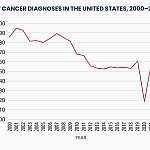
After declining significantly during the COVID-19 pandemic, substance use among adolescents has continued to hold steady at lowered levels for the fourth year in a row, according to the latest results from the Monitoring the Future Survey, which is funded by the National Institutes of Health (NIH). These recent data continue to document stable and declining trends in the use of most drugs among young people.
“This trend in the reduction of substance use among teenagers is unprecedented,” said Nora D. Volkow, M.D., director of NIH’s National Institute on Drug Abuse (NIDA). “We must continue to investigate factors that have contributed to this lowered risk of substance use to tailor interventions to support the continuation of this trend.”
Reported use for almost all measured substances decreased dramatically between 2020 and 2021, after the onset of the COVID-19 pandemic and related changes like school closures and social distancing. In 2022 and 2023, most reported substance use among adolescents held steady at these lowered levels, with similar trends and some decreases in use in 2024.
The Monitoring the Future survey is conducted by researchers at the University of Michigan, Ann Arbor, and funded by NIDA. The survey is given annually to students in eighth, 10th, and 12th grades who self-report their substance use behaviors over various time periods, such as past 30 days, past 12 months, and lifetime. The survey also documents students’ perceptions of harm, disapproval of use, and perceived availability of drugs. The survey results are released the same year the data are collected. From February through June 2024, the Monitoring the Future investigators collected 24,257 surveys from students enrolled across 272 public and private schools in the United States.
When breaking down the data by specific drugs, the survey found that adolescents most commonly reported use of alcohol, nicotine vaping, and cannabis in the 12 months prior to the survey, and levels generally declined from or held steady with the lowered use reported over the past few years. Compared to levels reported in 2023, data reported in 2024 show:
“Kids who were in eighth grade at the start of the pandemic will be graduating from high school this year, and this unique cohort has ushered in the lowest rates of substance use we’ve seen in decades,” said Richard A. Miech, Ph.D., team lead of the Monitoring the Future survey at the University of Michigan. “Even as the drugs, culture, and landscape continue to evolve in future years, the Monitoring the Future survey will continue to nimbly adapt to measure and report on these trends – just as it has done for the past 50 years.”
The results were gathered from a nationally representative sample, and the data were statistically weighted to provide national numbers. This year, 35% of students who took the survey identified as Hispanic. Of those who did not identify as Hispanic, 14% identified as Black or African American, 1% as American Indian or Alaska Native, 4% as Asian, 1% as Middle Eastern, 37% as white, and 7% as more than one of the preceding non-Hispanic categories. The survey also asks respondents to identify as male, female, other, or prefer not to answer. For the 2024 survey, 47% of students identified as male, 49% identified as female, 1% identified as other, and 3% selected the “prefer not to answer” option.
All participating students took the survey via the web – either on tablets or on a computer – with 99% of respondents taking the survey in-person in school in 2024.
The 2024 Monitoring the Future data tables highlighting the survey results are available online from the University of Michigan.
About the National Institute on Drug Abuse (NIDA): NIDA is a component of the National Institutes of Health, U.S. Department of Health and Human Services. NIDA supports most of the world’s research on the health aspects of drug use and addiction. The Institute carries out a large variety of programs to inform policy, improve practice, and advance addiction science. For more information about NIDA and its programs, visit www.nida.nih.gov.
About the National Institutes of Health (NIH): NIH, the nation's medical research agency, includes 27 Institutes and Centers and is a component of the U.S. Department of Health and Human Services. NIH is the primary federal agency conducting and supporting basic, clinical, and translational medical research, and is investigating the causes, treatments, and cures for both common and rare diseases. For more information about NIH and its programs, visit www.nih.gov.





